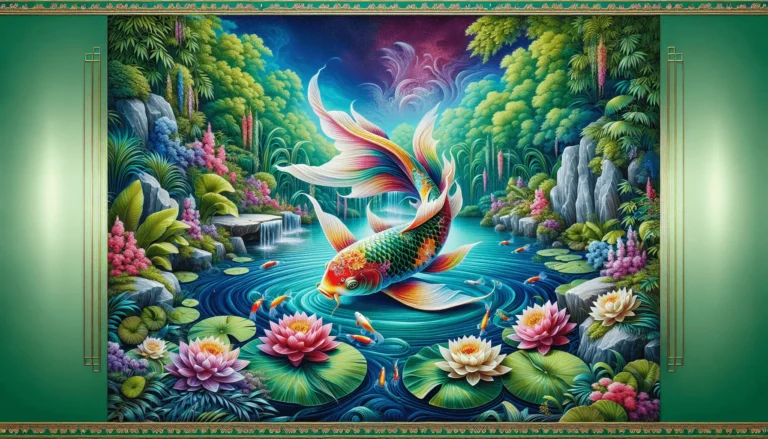Koi fish, often seen gliding gracefully in ornamental ponds, are adored for their vibrant colors and serene presence. Despite their popularity, many people still question: are koi fish smart? This article challenges the common misconception that koi fish lack intelligence.
While koi may appear docile, they possess a remarkable level of intelligence that often goes unnoticed. Studies and observations reveal that koi fish exhibit behaviors indicating memory, social interaction, and even trainability. Through this exploration, you’ll discover the hidden cognitive abilities of these fascinating creatures and gain a newfound appreciation for their intellectual capabilities.
The Cognitive World of Koi Fish
Understanding Intelligence in Fish
Intelligence in fish means their ability to:
- Understand and react to their surroundings
- Learn and remember things
- Solve problems
- Adapt to new situations
Studying koi fish’s cognitive abilities is important because it helps us:
- Understand their behavior better
- Take better care of them
- Appreciate the complexity of aquatic life
Unique Features of Koi Brains
Koi fish have special features in their brains that help them think and understand:
- Olfactory Bulbs: These are well-developed in koi and play a crucial role in smell, which is essential for locating food and recognizing individuals.
- Optic Tectum: Responsible for visual processing, this part of the brain helps koi navigate using visual landmarks.
- Cerebellum: Although simpler than in mammals, it is involved in motor control and coordination, enabling koi to perform complex swimming patterns.
By studying these features, we can learn more about how koi fish process information and interact with their environment.
1. Understanding Individuality and Memory Skills
Koi fish have an incredible ability to recognize familiar faces, showing their impressive memory skills. Studies have found that koi can tell the difference between people, especially those who feed them regularly. This ability to recognize faces isn’t just random; it shows their long-term memory in koi fish.
Recognizing Familiar Faces
Koi fish can remember and tell apart individual humans. When owners interact with their koi consistently, these fish start associating specific people with positive experiences like feeding times. For example:
- Feeding Habits: Koi often swim towards the edge of the pond when they see a familiar person coming, expecting food. This behavior shows that they remember who feeds them and respond accordingly.
- Behavioral Reactions: Certain individuals may notice koi following their hands or even allowing themselves to be touched, while being cautious around strangers.
REad Also: Understanding Koi Fish Aggression: Facts & Insights
Long-Term Memory in Feeding Habits
Long-term memory in koi plays a big role in their daily routines, especially during feeding habits. It’s not just about recognizing faces but also remembering feeding schedules and locations.
- Regular Feeding Spots: Koi often gather at specific places where they are regularly fed, showing their ability to remember exact locations over long periods.
- Routine Changes: Changes in feeding times or methods can initially confuse koi, but they quickly adjust due to their strong memory skills, showing an understanding of new patterns.
By studying these behaviors, it’s clear that koi fish have cognitive abilities that help them navigate social interactions effectively. This intelligence further emphasizes the importance of considering their mental stimulation needs along with their physical care.
2. Social Dynamics: Hierarchies and Their Impact on Koi Intelligence

Social behavior in koi fish reveals complex interactions that are often underestimated. Much like other social animals, koi establish dominance hierarchies within their groups. These hierarchies consist of dominant and submissive roles, which can influence the overall social dynamics of the pond.
Dominance Hierarchies
Koi fish exhibit clear social structures:
- Dominant koi: Typically larger or more aggressive, these fish assert control over resources such as food and space. They often lead the group during feeding times.
- Submissive koi: These fish avoid conflict with dominant individuals and tend to stay on the periphery during feeding.
This social stratification is not just about physical size or strength. Behavioral traits also play a crucial role in establishing one’s position within the hierarchy.
Influence on Well-being
Social interactions among koi can significantly impact their well-being and happiness:
- Stress levels: High levels of aggression from dominant individuals can lead to increased stress among submissive koi. Stress negatively affects their health and immune system.
- Feeding efficiency: Submissive koi may have less access to food, leading to nutritional deficiencies if the hierarchy is too rigid.
- Social learning: Positive social interactions facilitate learning and adaptation. Submissive koi often observe and mimic behaviors from dominant individuals, aiding in their own survival strategies.
Understanding these dynamics helps in creating a harmonious environment for your koi pond. By recognizing the importance of social structures, you can ensure each fish thrives both physically and mentally, thus enhancing their overall intelligence and quality of life.
3. The Art of Training Koi Fish: A Testament to Their Trainability
Training koi fish is a delightful endeavor that showcases their remarkable trainability and intelligence. By using positive reinforcement techniques, you can teach them to eat from your hand and even perform simple tricks.
Hand-Feeding Techniques
To train koi to eat from your hand, patience and consistency are crucial. Follow these steps:
- Choose the Right Food: Select high-quality koi food that they find irresistible.
- Establish a Routine: Feed them at the same time and place each day to create a sense of familiarity.
- Gradual Introduction: Start by placing food near the edge of the pond, gradually moving it closer to your hand.
- Hand Positioning: Hold your hand steady in the water with food pellets until they come close enough to eat from your palm.
Positive reinforcement plays a key role here. Each successful attempt should be rewarded with food, encouraging them to repeat the behavior.
Fun Tricks for Intelligent Koi
Koi fish’s willingness to learn extends beyond hand-feeding. You can teach them several entertaining tricks, similar to what can be found in this guide on how to train fish:
- Follow the Finger: Use a pointer or your finger to guide them around the pond. Reward them when they follow accurately.
- Hoop Jumping: Train them to swim through hoops submerged in water using food rewards.
- Color Recognition: Place colored markers in the pond and reward koi for swimming towards specific colors.
Koi fish respond well to training because of their strong associative learning capabilities. They quickly understand that certain behaviors lead to rewards, making them eager participants in training sessions.
Training not only enhances their cognitive abilities but also strengthens the bond between you and your koi, making it a rewarding experience for both parties involved.
Read Also Ultimate Guide to Raising Koi Fish: Care, Feeding & Health
4. Emotional Depths: Recognizing Behavioral Cues and Understanding Koi Emotions
Understanding the emotional states of koi fish involves keen observation of subtle behavioral changes. Recognizing these cues is essential for maintaining their well-being.
Stress Signals in Koi Fish
Koi fish exhibit specific behaviors when under stress:
- Erratic Swimming: Rapid, uncoordinated movements.
- Loss of Appetite: Refusal to eat during feeding times.
- Isolation: Avoiding interaction with other fish or staying in one spot.
Identifying these stress signals early can help you take corrective actions to improve their environment. Research has shown that such stress responses are not just physical but also affect their emotional state.
Happiness Indicators
Indicators of a content koi include:
- Active Swimming: Regular, smooth movements around the pond.
- Eager Feeding: Approaching readily during feeding times.
- Social Interaction: Engaging with other fish and exploring their surroundings.
Healthy koi often display an eagerness to interact both with humans and fellow koi, indicating a positive emotional state. This aligns with findings that highlight the importance of social interactions in promoting emotional health, not just in humans but also in animals.
Creating an Emotionally Supportive Environment
An environment conducive to emotional health includes:
- Clean Water: Regular filtration and maintenance ensure optimal water quality.
- Adequate Space: Providing enough room for swimming reduces stress levels.
- Enrichment Elements: Including plants, rocks, and hiding spots enhances mental stimulation and security.
By tailoring their habitat to meet these needs, you support not only their physical health but also their emotional well-being. It’s important to note that the mental health of koi can be significantly improved by such environmental adjustments.
Observing and responding to the subtle behavioral cues of your koi can significantly enhance their quality of life. Their emotional health is just as crucial as their physical state, requiring attentive care and an enriching environment.
5. Environmental Influences on Koi Intelligence: Water Quality Matters!

Ensuring optimal water quality is essential for the cognitive function of koi fish. Clean and well-maintained water conditions directly impact not just their physical health but also their mental sharpness.
Key Factors Affecting Koi Intelligence
- Oxygen Levels: Adequate oxygenation is crucial as it affects brain function. Poor oxygen levels can lead to lethargy and impaired cognitive abilities.
- Toxin-Free Environment: High levels of ammonia, nitrites, and nitrates can be detrimental. These toxins can cause stress and neurological damage, reducing the koi’s ability to learn and remember.
- Consistent Temperature: Stable water temperatures help maintain metabolic rates, which are closely linked to cognitive functions. Fluctuating temperatures can induce stress and hinder mental processes.
The Impact of Clean Water on Koi Intelligence
Studies have shown that koi fish in clean water environments exhibit better memory retention and learning capabilities. For those wondering, are koi fish smart? The answer lies partly in how well they are cared for—clean water being a significant factor.
Maintaining excellent water quality not only benefits their health but also allows these intelligent creatures to thrive cognitively.
Read Also: How to Sell Koi Fish: Pricing, Quality, and Market Tips
6. Navigating Through Life: Exploring Koi’s Exceptional Navigation Skills and Sensory Perception Abilities
Koi’s navigation skills are a fascinating blend of their senses and understanding of space. These fish use what they see around them to move through their world, showing a kind of smartness that we often overlook.
Visual Landmarks and Navigation
Koi fish rely heavily on visual cues to recognize and remember their surroundings. This ability is particularly evident in well-structured ponds where specific objects or plants can serve as reference points.
- Spatial Memory: Koi can remember where they find food by linking it to things they see. This helps them easily return to those places.
- Obstacle Avoidance: In ponds with diverse structures, koi learn to avoid obstacles by memorizing their positions, showcasing their ability to form mental maps.
Taste and Smell: Key Sensory Inputs
Besides visual cues, koi fish also use their acute senses of taste and smell to enhance their navigation and learning processes.
- Finding Food: The sense of taste allows koi to detect food particles in the water, guiding them towards feeding areas even in murky conditions.
- Chemical Cues: Smell plays a crucial role in recognizing chemical signals from other fish or environmental changes, aiding in social interactions and habitat exploration.
Real-Life Examples
Observations from koi enthusiasts highlight how these fish use their navigation skills and sensory perception:
“In my pond, I’ve noticed that my koi always swim directly to the feeding spot as soon as I approach. They seem to remember not just the location but also my presence, indicating a strong link between visual recognition and memory.” – A Koi Hobbyist
Another interesting example involves a study where koi navigated mazes using visual landmarks:
“Researchers placed different colored markers at maze junctions. Koi were able to remember the correct path by associating turns with specific colors, demonstrating their capability for complex spatial learning.”
These examples underscore how koi fish leverage both visual landmarks and sensory inputs like taste and smell to navigate their aquatic world effectively.
7. Beyond Ponds: Investigating Hidden Cognitive Abilities Within Aquatic Environments & Future Research Directions
Research studies highlight intelligent behaviors across various aquatic species, broadening our understanding beyond koi. For instance, goldfish have shown advanced learning capabilities, such as recognizing shapes and colors to navigate mazes. This indicates a level of cognition that parallels what we’ve observed in koi.
Evidence Supporting High-Level Cognition Among Different Species:
- Goldfish: Known for their ability to learn and remember complex tasks, they exhibit behaviors like swimming through hoops and responding to specific auditory cues.
- Cichlids: Display intricate social structures and mating rituals, showcasing advanced social reasoning.
- Octopuses: Exhibit problem-solving skills and use tools, demonstrating high-level cognitive abilities.
Exploring these behaviors in different species emphasizes the potential for complex cognition within aquatic environments. This aligns with the broader perspective that animals, including aquatic ones, possess varying degrees of intelligence, which is often underestimated.
Avenues for Future Investigation:
- Diverse Settings: Moving beyond traditional laboratory experiments can provide more naturalistic insights into fish intelligence. Observing them in varied environments like ponds, rivers, and oceans could reveal new cognitive abilities.
- Inter-Species Comparisons: Comparing cognitive functions across different types of fish can help identify commonalities and unique traits in intelligence.
- Technological Integration: Utilizing advanced technologies such as underwater drones and AI-powered monitoring systems can enhance observational studies, providing deeper insights into fish behaviors.
Expanding research to include diverse settings and species will enrich our understanding of aquatic intelligence, revealing the hidden depths of cognition among these fascinating creatures. Such investigations could also delve into the cognitive complexities present within different animal species, further enhancing our comprehension of their behavioral patterns and mental processes.
Conclusion
Understanding koi intelligence reveals the remarkable cognitive abilities of these elegant fish. By recognizing their intelligence, you can:
- Implement better care practices: Ensure clean water and an enriching environment for both physical and mental health.
- Engage in interactive activities: Build trust through hand-feeding and teaching tricks.
Appreciating the hidden intelligence of koi enriches your bond with them and enhances their well-being. Are koi fish smart? Absolutely, and acknowledging this can lead to more fulfilling experiences for both you and your finned companions.
FAQs (Frequently Asked Questions)
Are koi fish really smart?
Yes, koi fish possess a remarkable level of intelligence that is often underestimated due to their docile nature. This article aims to debunk the common misconception that koi fish are not smart.
What cognitive abilities do koi fish have?
Koi fish exhibit various cognitive abilities, including long-term memory and facial recognition. Their unique brain structure contributes to these capabilities, allowing them to recognize familiar faces and remember feeding practices.
How do social dynamics affect koi intelligence?
Koi fish have complex social structures, including dominance hierarchies. These social interactions can significantly influence their overall well-being and happiness, highlighting the importance of understanding their social behavior.
Can koi fish be trained?
Yes, koi fish can be trained using positive reinforcement methods. Techniques such as feeding them by hand can showcase their willingness to learn, and they can even learn fun tricks through consistent training.
How does water quality impact koi intelligence?
Water quality plays a crucial role in both the physical health and cognitive function of koi fish. Clean water is essential for optimal brain function, which directly affects their intelligence and overall well-being.
What are some exceptional navigation skills of koi fish?
Koi fish use visual landmarks for navigation and also rely on other senses like taste and smell. Real-life examples demonstrate how these sensory perceptions contribute to their learning processes and ability to navigate their environment.




